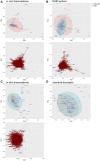RAID: Regression Analysis-Based Inductive DNA Microarray for Precise Read-Across
- PMID: 35935858
- PMCID: PMC9354856
- DOI: 10.3389/fphar.2022.879907
RAID: Regression Analysis-Based Inductive DNA Microarray for Precise Read-Across
Abstract
Chemical structure-based read-across represents a promising method for chemical toxicity evaluation without the need for animal testing; however, a chemical structure is not necessarily related to toxicity. Therefore, in vitro studies were often used for read-across reliability refinement; however, their external validity has been hindered by the gap between in vitro and in vivo conditions. Thus, we developed a virtual DNA microarray, regression analysis-based inductive DNA microarray (RAID), which quantitatively predicts in vivo gene expression profiles based on the chemical structure and/or in vitro transcriptome data. For each gene, elastic-net models were constructed using chemical descriptors and in vitro transcriptome data to predict in vivo data from in vitro data (in vitro to in vivo extrapolation; IVIVE). In feature selection, useful genes for assessing the quantitative structure-activity relationship (QSAR) and IVIVE were identified. Predicted transcriptome data derived from the RAID system reflected the in vivo gene expression profiles of characteristic hepatotoxic substances. Moreover, gene ontology and pathway analysis indicated that nuclear receptor-mediated xenobiotic response and metabolic activation are related to these gene expressions. The identified IVIVE-related genes were associated with fatty acid, xenobiotic, and drug metabolisms, indicating that in vitro studies were effective in evaluating these key events. Furthermore, validation studies revealed that chemical substances associated with these key events could be detected as hepatotoxic biosimilar substances. These results indicated that the RAID system could represent an alternative screening test for a repeated-dose toxicity test and toxicogenomics analyses. Our technology provides a critical solution for IVIVE-based read-across by considering the mode of action and chemical structures.
Keywords: alternative method; gene expression analysis; hepatotoxicity; new approach methodology; oligonucleotide array.
Copyright © 2022 Amano, Yamane and Honda.
Conflict of interest statement
YA, MY, and HH were employed by the company Kao Corporation.
Figures







Similar articles
-
In vitro to in vivo extrapolation for drug-induced liver injury using a pair ranking method.ALTEX. 2017;34(3):399-407. doi: 10.14573/altex.1610201. Epub 2017 Jan 11. ALTEX. 2017. PMID: 28073113
-
IVIVE: Facilitating the Use of In Vitro Toxicity Data in Risk Assessment and Decision Making.Toxics. 2022 May 1;10(5):232. doi: 10.3390/toxics10050232. Toxics. 2022. PMID: 35622645 Free PMC article. Review.
-
Systematically evaluating read-across prediction and performance using a local validity approach characterized by chemical structure and bioactivity information.Regul Toxicol Pharmacol. 2016 Aug;79:12-24. doi: 10.1016/j.yrtph.2016.05.008. Epub 2016 May 9. Regul Toxicol Pharmacol. 2016. PMID: 27174420
-
Considerations for Improving Metabolism Predictions for In Vitro to In Vivo Extrapolation.Front Toxicol. 2022 Apr 29;4:894569. doi: 10.3389/ftox.2022.894569. eCollection 2022. Front Toxicol. 2022. PMID: 35573278 Free PMC article. Review.
-
Bridging the Data Gap From in vitro Toxicity Testing to Chemical Safety Assessment Through Computational Modeling.Front Public Health. 2018 Sep 11;6:261. doi: 10.3389/fpubh.2018.00261. eCollection 2018. Front Public Health. 2018. PMID: 30255008 Free PMC article. Review.
References
LinkOut - more resources
Full Text Sources
Miscellaneous

